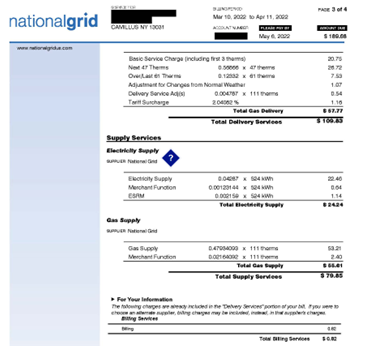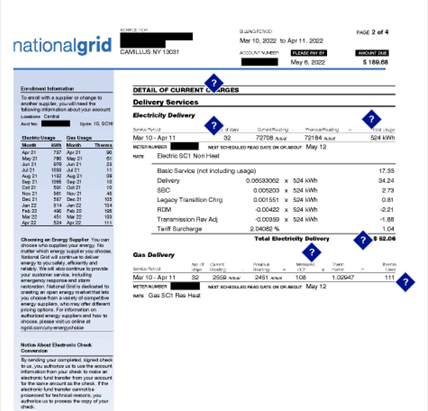Understanding Your National Grid Utility Bill: A Comprehensive Guide

If you’re a commercial or industrial customer in our New York service area, you’re likely getting your utility bill from several companies. One of them is the National Grid (NGRID)—formally known as Niagara Mohawk Power (NIMO). This article will explain your monthly NGRID utility bill, break down what you’re paying for, and highlight where you can save. For reference, we’ve spelled out some of the typical language you’ll find on your bill, like the difference between supply and transmission and how to read kilowatt-hours (kWh) on your bill.
Your NGRID bill includes:
- A 10-digit account number
- Your summary of current charges and account balance
- A chart of your electric usage history and your average daily energy consumption and cost
- Your delivery charge breakdown
- Your supply charge breakdown
Supply Charges
Your NGRID supply charges are on page 3 of your utility bill. With NGRID you have the option to select your energy supplier. If you opt for an energy service company (ESCO) besides NGRID, your Supply Services will list your new ESCO, including your electricity supply costs.
For NGRID customers, your supply charges reflect your electricity supply and gas supply. There is a merchant function charge listed for both charges. If you recall from our previous blog post, your merchant function is a charge for purchasing gas or electricity supply on your behalf. The “ESRM” on your bill stands for Electricity Supply Reconciliation Mechanism. This is on your utility bill each month when customers are with the utility for supply and there will be a charge or a credit.

Delivery Charges
NGRID customers will find their delivery charges on page 2. This page shows your total usage and a breakdown of your delivery charges including electricity and gas. Under your electricity charges, you have your basic service charges—this doesn’t include your actual usage. It’s a fixed rate no matter how much electricity your business consumes. Your total usage reflects the kilowatt hours you used between your previous meter reading and current meter reading. At the bottom of the page, under your gas charges, you’ll notice how many “therms” you used during this period as well as the total quantity of gas you used (measured as Cubic Feet).
The amount of therms used during this billing cycle that are listed on this page tells NGRID how much heat was required at your business. The higher your therms are, the higher your utility bill will be. The “RDM” listed under your delivery charges stands for Revenue Decoupling Mechanism—it’s how NGRID makes previsions on the revenues of customers’ delivery services. When the target for delivery revenues is reached, the surplus amount will be refunded to the customer. If not, NGRID collects this money from its customers.

Reviewing the breakdown of your supply and demand charges creates a better picture of where your costs come from and the “why” behind your utility bill.
| Key Takeaways |
| You may save on your supply costs through fixed or market flex pricing through Catalyst Power. Download our Retail Pricing Guide for more information. |



